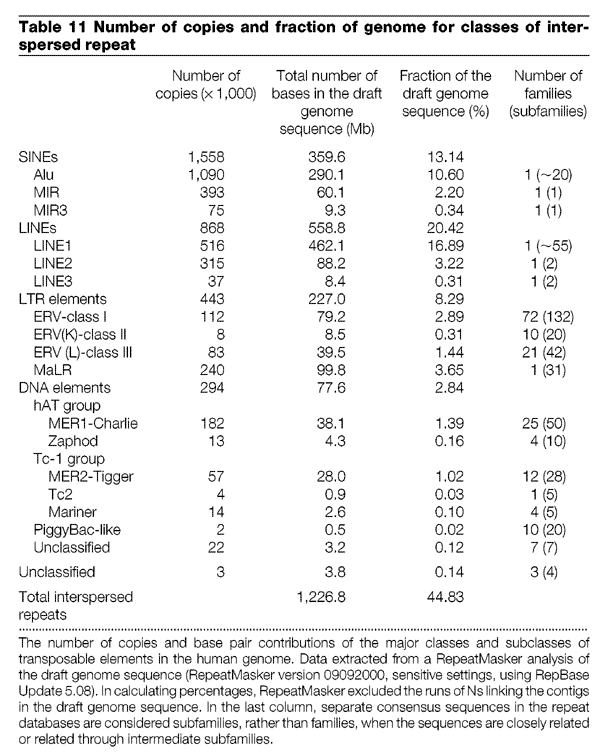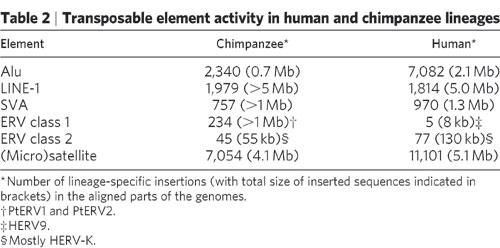What are these false assumptions?
They start with this one:
The doctrine that species, including man, are descended from other species. He first did the eminent service of arousing attention to the probability of all change in the organic, as well as in the inorganic world, being the result of law, and not of miraculous interposition. (Darwin, On the Origin of Species)
Then they grow to include viral germline invasions that would be a formula for extinction.
If they are highly deleterious, how are humans able to survive with 8% of our genome being made up of inserted retroviruses? The facts disprove your claims. We are able to tolerate them just fine.
We didn't survive them, those are broken reading frames, nothing more. That's another false assumption of a cause that cannot be proven or even explained.
I already have on multiple instances, including conversations with you.
Human genome paper, Table 11. This table shows over 200,000 in the human genome.
http://www.nature.com/nature/journal/v409/n6822/fig_tab/409860a0_T11.html
Table 2 from the chimp genome paper. It shows less than 300 chimp specific ERVs and less than 100 human specific ERVs.
http://www.nature.com/nature/journal/v437/n7055/fig_tab/nature04072_T2.html
Against this background, it was surprising to find that the chimpanzee genome has two active retroviral elements (PtERV1 and PtERV2) that are unlike any older elements in either genome; these must have been introduced by infection of the chimpanzee germ line. The smaller family (PtERV2) has only a few dozen copies, which nonetheless represent multiple (~5–8) invasions, because the sequence differences among reconstructed subfamilies are too great (~8%) to have arisen by mutation since divergence from human. (Chimpanzee Genome, Nature 2005)
That's not the only surprise.
With more than 100 members, CERV 1/PTERV1 is one of the most abundant families of endogenous retroviruses in the chimpanzee genome. (
Genome Biol. 2006). Still ignoring that fact!
You left out greater then a million base pairs.
This means that out of 200,000 ERVs found in the human genome, all but 100 are found at the same location in the chimp genome. Out of the 200,000+ ERVs in the chimp genome, all but 300 are found at the same location in the human genome.
That's twice in one post you did that. First you beg the question of proof with regards to viral germline invasions becoming permanently fixed. Then you pretend that the ones in the Chimpanzee genome are exactly the same as the ones in humans which is clearly contradicted by the facts:
PtERV1-like elements are present in the rhesus monkey, olive baboon and African great apes but not in human, orang-utan or gibbon, suggesting separate germline invasions in these species (Chimpanzee Genone)
I have fully incorporated the fact, as shown by the table above. I show that chimps have about 300 species specific insertions, most of them being PtERV insertions.
You quoted and posted the table, just left out an actual argument.
Did you also forget that the paper you are referencing only looked at 425 ERVs in total?
"Using the procedure described above, we identified a total of 425 full-length chimpanzee endogenous retroviruses. This is certainly an underestimate of the number of endogenous retroviruses in the chimpanzee genome because we consciously excluded any sequences that could not be unambiguously identified as an endogenous retrovirus."
http://www.ncbi.nlm.nih.gov/pmc/articles/PMC1779541/
No
We identified a total of 425 full-length chimpanzee endogenous retroviruses. This is certainly an underestimate of the number of endogenous retroviruses in the chimpanzee genome because we consciously excluded any sequences that could not be unambiguously identified as an endogenous retrovirus. (Genome Biol. 2006)
Are you still ignoring this fact?
Are you completely oblivious to the context of the statement?
Why would we have to ignore the differences? The differences are what evolution is all about. Those differences are the end product of evolution, after all.
An assumed evolutionary process, as applied to a natural history that is little more then a myth.
You would first need to show that they are deleterious.
You think I need to prove that germline invasions are deleterious? Not really interested in chasing that one around the mulberry bush.

The diversity of the earliest stages of development, here illustrated strictly within the vertebrates, provides one of the strongest challenges to the neo-Darwinian conception of homology and macroevolution. Given the hierarchical, step-wise logic or "architecture" of animal development, early stages such as cleavage and gastrulation lay the groundwork for all that follows. Body plan structures in the adult, for example, trace their cellular lineage to these early stages. Thus, if macroevolution is going to occur, it must begin in early development. Yet it is precisely here, in early development, that organisms are least tolerant of mutations. Furthermore, the adult homologies shared by these vertebrates commence at remarkably different points (e.g., cleavage patterns). How then did these different starting points evolve from a common ancestor? (
Homology: A Concept in Crisis)
That's just for starters, when mutations have an effect, and ERVs would definitely would have an effect on germline cells, they are almost always deleterious. In the case of germline cells they would most likely be fatal. Darwinism doesn't have to worry about that because an assumed ancient and prehistoric history is never questioned.
We are arguing that evolution is supported by the observed pattern of both similarities AND DIFFERENCES. That pattern is a nested hierarchy. We are making a phylogenetic argument, not a similarity argument. It is the match between the tree based on morphology and the tree based on DNA sequences that evidence evolution, and those trees are based on both similarities and differences.
We huh? In case you missed it the crowd isn't turning into a mob as they did in the past. At any rate you are obviously trying to mimic an homology argument, that much is obvious. What you seem unwilling or unable to come to terms with is the enormous diversity and an obvious inverse logic. If the similarities are evidence for common ancestry are the differences an argument for independent lineage? The inverse logic is intuitively obvious. What's more you pretend that they are identical in humans and chimpanzees and nothing could be further from the truth.
They do develop into gills in fish, and you have not made a substantive argument otherwise.
No they don't and no you haven't.
Finding a deleterious mutation does not mean that all mutations are deleterious. Simple logic, yet you can't figure it out.
Are the 40 million mutations that separate the human and chimp genome deleterious to humans? Yes or no?
They are differences, 35 million base pair differences and 5 million gaps totaling about 90 million base pairs of divergence. They are only assumed to be the result of mutations, just like the ERVs, just like the three fold expansion of the human brain from that of apes.
Pointing to divergence between genomes is a problem for a theory that explains how nature produces divergence between genomes? Really?
We are talking about comparative genomics, the explanation for how those differences came about begs the question of proof on it's hands and knees.
What next? Will you point to modern river eroding a valley as evidence against the theory that rivers erode valleys? Will you point to bacteria causing disease as a disproof of the germ theory of disease?
Pull up dude, you going into a pedantic, sardonic downward spiral.
Do you even understand what the theory of evolution proposes?
Do you even know what the word means? How about the words genomic comparison, do you get what that means?
What is it about indels that you think needs explaining?
They are not indels, the are gaps in the sequences that exist in one sequence but not in the other. It never ceases to amaze me how such devout evolutionists fail to understand the most basic and obvious facts. I lost interest in the subject matter after it got to be fish in a barrel. What really interests me are the evolutionists who seem incapable of basic insights and cursory reading. Curious, very curious indeed.
Have a nice day

Mark




